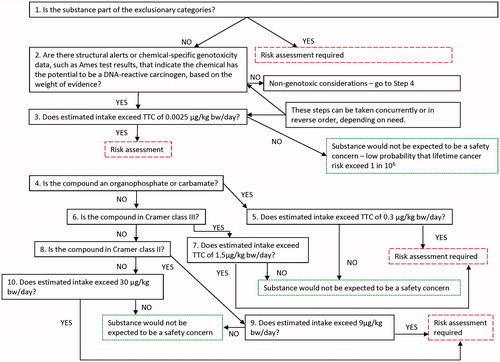Figures & data
Figure 1. Tiers of the TTC concept as described in the WHO EFSA Report 2016 (EFSA Citation2016). For explanation of the “exclusionary categories” see section on “Outline of current TTC scheme”. The dashed boxes (green in online version) indicate where a conclusion on the acceptability of estimated human exposure can be reached. The longdash boxes (red in online version) indicate where safety at estimated human exposure cannot be assured and further information would be necessary to enable completion of the assessment.

Table 1. Genotoxicity profiles of Ames-positive carcinogens (taken from the approaches used in compiling the database of Kirkland et al. (Citation2014) that are considered the strongest candidates to exert a genotoxic mode of action for carcinogenicity in descending order of confidence (Group1 strongest, group 6 weakest evidence). In vivo effects in the target tissue (and target species) for carcinogenicity would carry particular weight.
Table 2. A summary of freely available sets of rules, or profilers, which may be used to identify genotoxic carcinogens from the OECD QSAR toolbox.
Table 3. A summary of commercially available expert systems based on structural alerts for the identification of genotoxic carcinogens.
Table 4. A summary of computational systems to predict mutagenicity and related endpoints based on SAR, QSAR, or hybrid systems.
